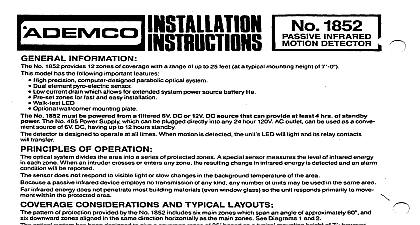Ademco - 996-998 Passive Infrared Motion Detector

File Preview
Click below to download for free
Click below to download for free
File Data
| Name | ademco-996-998-passive-infrared-motion-detector-5290674381.pdf |
|---|---|
| Type | |
| Size | 984.76 KB |
| Downloads |
Text Preview
N8023 Rev C 8 97 INFRARED MOTION DETECTORS INSTRUCTIONS INFORMATION passive infrared motion detectors are versatile wall mounted units employing lenses and offering efficient protection patterns for commercial and residen applications Best coverage will be obtained if mounting is selected such that the direction of intruder motion is across the pattern 998 detector is equipped with optics to cover the normally zone directly beneath a detector downward looking optics not present on the detectors are shipped with the standard wide angle lens installed Two inter lenses the 99LR Long Range lens and the 99PA Pet Alley lens are with the 998 detector these lenses are optional for the 996 optional swivel mounting bracket is available under part number 998SB Method Infrared Wide Angle Lens ft x 50 ft 15.2m x 15.2m 90 Long Range Lens ft x 10 ft 30m x 3m Pet Alley Lens ft x 70 ft 15m x 21.3m 100 zones 9 long range 5 intermdiate and 4 short range zones 1 long range 2 intermediate 2 short range zones or Standard selectable via DIP switch 998 and detector provides a single zone with all lenses downward looking window must be masked when using the 99PA Pet Alley lens Count Rate Height Relay 5ft sec 15 1.5m sec nominal 2.1m LED enabled disabled via DIP switch A SPST 0.5A contact rating DC protective resistor VDC voltage reversal makes PIR inoperative mA non alarm nominal mA alarm nominal source should be capable of at least 4 hours of battery 122 10 to 50 to 95 RH max x 4 3 8 x 2 1 8 max protrusion 67mm x x 54mm Voltage Temp for 996 for 996 Zones Lens Pattern Standard Lens ONLY Pattern 99LR Long Range Lens Pattern 99PAPet Alley Lens Normal Surface Mounting the unit to a firm vertical surface The wall wiring hole should be no more than 8mm diameter Remove the front cover as shown in Figure 1 Refer to Figure 2 Knockout holes in the base are for normal surface mount on a wall slide PC board up for access to bottom holes down for access to holes For corner mounting see B Corner Mounting Also break out the wire entry hole at this time marked X1 or X2 in Fig 2 Feed wiring emerging from the wall through the wire access hole near the top of detector base Make sure wires have sufficient slack to allow the PC board be moved up and down freely when the wires are connected to the terminals the board Mount the base Note the mounting orientation of this detector wire entry the top lens at the bottom Make sure the board is positioned so that the is in line with the appropriate setting on the graduated scale see Fig 5 Table 1 Refer to the WIRING CONNECTIONS section before replacing the front cover Corner Mounting holes in the base are used for corner mounting on a wall slide PC up for access to bottom holes down for access to top holes and mount in corner with 4 screws the mounting orientation of this detector wire entry at the top lens the bottom Make sure the board is positioned so that the arrow is in line the appropriate setting on the graduated scale see Fig 5 and Table 1 Changing Lenses if required Remove front cover Release the lens support frame located in front cover as follows insert the blade a small screwdriver between the locking tab and the detector case in each of four corners of the frame and lever each tab upward to release See Figure When all four corners are released remove the lens support frame Remove the existing lens and replace with the replacement lens The lens must installed with the smooth side facing outward Also the lens should be with its part number on the upper right hand side Be sure to cen the lens Lens surface should be free of dirt foreign matter and fingerprints Use a dry soft cloth to wipe lens surfaces the lens support frame into its original position and then press downward the frame so that the lens locking tabs snap into position in each of the four Refer to E Vertical Pattern Adjustment and Table 1 for recommended detec pattern setting for various mounting heights and protection ranges Replace front cover Horizontal Adjustment of Lens protection pattern can be moved to the left or right by horizontal adjustment as Remove front cover Grasp the lens firmly on both sides front and back and slide the lens to the left right as needed The lens may be moved as much as 4 from center in direction Replace front cover adjustment conduct a walk test to ensure proper coverage of the area to be see Procedures Vertical Pattern Adjustment protection pattern can be raised or lowered by re positioning the PC board in detector A graduated scale to the left of the board see Fig 5 indicates the number of degrees by which the pattern can be raised max 5 or max 20 To make this adjustment slide the board upward or downward the number of degrees required After any adjustment conduct a walk test to proper coverage of the area to be protected see Procedures 1 indicates the recommended setting at various mounting heights and protec ranges for each of the available lenses Lens Masking supplied masking strips can be used to produce a protection pattern that suits particular requirements of the protected area or eliminate coverage from areas you anticipate environmental disturbances that might educe the PIR stability heater or other heat producing object for example Simply peel off the appropri pressure sensitive adhesive strip s and apply over the desired segment s Be sure to affix the masking strips to the insideof the lens not the smooth side Each lens segment that is masked results in the elimination of zone of protection from the coverage pattern label over the look down window using the Pet Alley lens in the 998 be sure to affix the provided REMOVE COVER THE MOUNTING OF THIS WIRE ENTRY AT THE TOP AND LENS AT THE BOTTOM INSERT SCREWDRIVER IN GROOVE AND TWIST 1 Cover Removal 12V RELAY CORNER 4 HOLES SURFACE 4 TOP WIRE ENTRY WIRING REAR WIRE ENTRY WIRING 2 Detector Base SCREWS USE 4 3 Corner Mounting BLADE TAB AND INWARD TO EACH OF LENS THEN LENS 4 Changing Lenses 12V RELAY 2 3 UP LED DISABLE ENABLE UP INTERMEDIATE PULSE COUNT STANDARD PULSE COUNT NOT USED POWER CLOSED LOOP 3 4 5 Wirng Connections CONNECTIONS all wires in through the wire access slot at the top of the detector base near terminal block and connect to the screw terminals see Fig 5 for wiring details any openings in the base with foam or RTV not supplied to prevent drafts or from entering the unit Apply power only after all connections have been and are inspected ENABLE DISABLE OPTION enable the LED set the DIP switch 1 DOWN see Fig 5 for switch location disable the LED set DIP switch 1 UP Use a small pointed tool to move the handle up or down COUNT OPTION Intermediate Pulse Count set the Pulse Count DIP switch 2 UP see Fig 5 switch location For Standard Pulse Count set DIP switch 2 DOWN Use a pointed tool to move the switch


